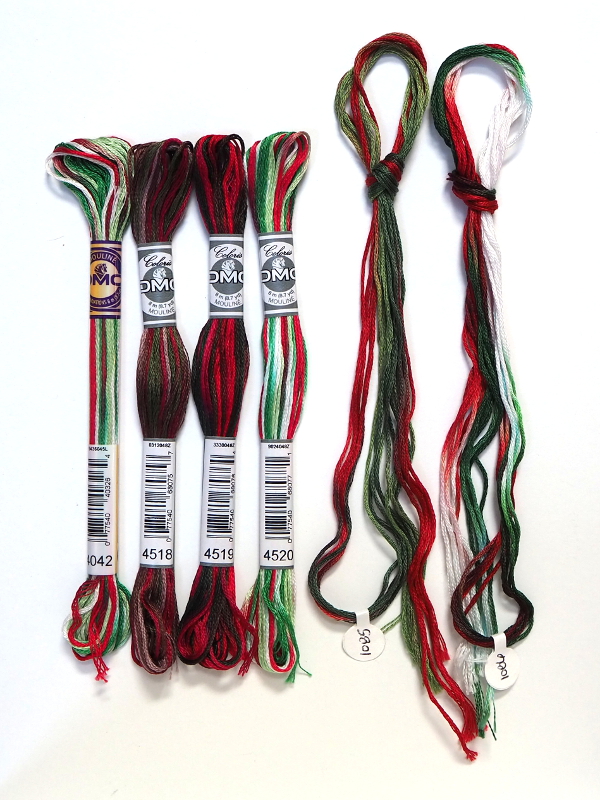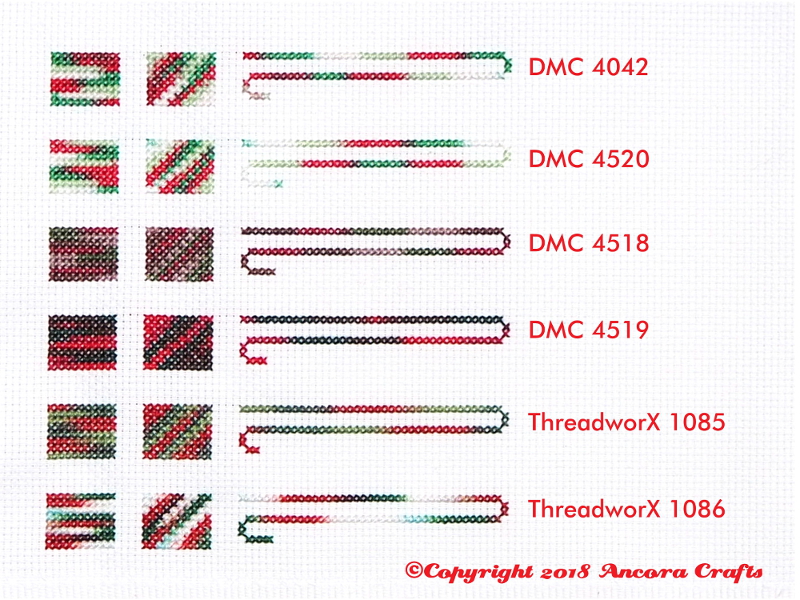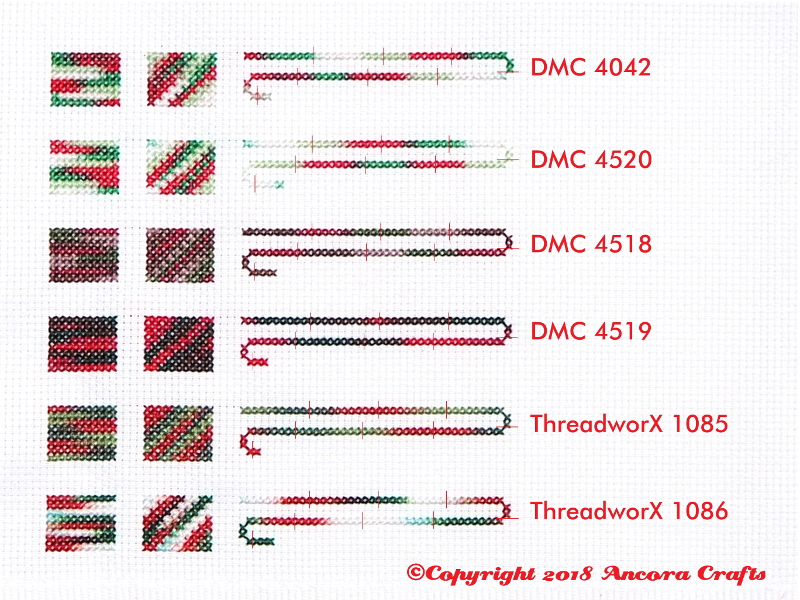This festive variegated Christmas floss comparison will show some of the available color combinations, explain differences between brands, and show examples of how these gorgeous threads stitch. [Update 2023: There are more Christmas flosses available in my shop now, including ThreadworX 1084, ThreadworX 1087, and my 10-color ThreadworX Chrismas Collection, as well as a Christmas Tree Sampler Pattern.]
The photo below shows the six flosses in this comparison: DMC 4042, DMC 4518, DMC 4519, DMC 4520, ThreadworX 1085, and ThreadworX 1086. For years I’ve been curious to see if there was any difference between DMC 4042 and DMC 4520 and this comparison was the perfect opportunity to find out!
Below shows how wonderful these flosses look when stitched on 14 count Aida. The samples on the left were stitched horizontally, the samples in the middle were stitched diagonally, and the samples at right were stitched horizontally, all in a serpentine order. 
As ThreadworX floss comes in one yard segments (rather than the continuous 8.7 yard DMC skeins), I used one yard of each floss to stitch the samples, using two strands of the six strand flosses.
DMC 4042 (named Very Merry) and DMC 4520 (Christmas Story), are the same combination of cherry red, white, light green, and bright green.
DMC 4518 (Cottage) includes brown, dusty pink, dark mossy green, and dark cranberry. I can easily see this floss, like its name, in a cottage or country Christmas themed project.
DMC 4519 (Jingle Bells) is a mix of red, dark raspberry, dark forest green and brown. The dark brown makes me think of pine cones and the red of berry garlands.
ThreadworX 1085 (Christmas Time) combines leafy green, forest green, and red. I think this one could easily be used with other colors of floss to create festive Christmas palettes.
ThreadworX 1086 (Christmas Candy) is the closest contemporary to the DMC 4042 and 4520 with its classic red, white, and green colors. However, the ThreadworX green and red are slightly darker than the DMC shades.
This image shows how the colors repeat:
The red arrows indicate where the color progression in the DMC floss does a U-turn on itself. Take for example the DMC 4520. On either side of the arrow, the colors progression is the same: from green to red to light green to white to green, etc. Every DMC variegated floss does the same at some point.
I was curious to see the distance between the U-turns, so I cut a longer piece of the DMC 4042.
The two U-turns are marked with arrows on the left. The length of the floss between the two arrows is approximately 33.5 inches (85 cm). Starting from the top arrow the color order is green-red-light green-white / green-red-light green-white / green-red-light green-white. Then at green it U-turns and reverses the order to green-white-light green-red, etc.
This U-turn in the color progression, I’m sure, has to be a function of DMC’s manufacturing process. Unfortunately, I can find no information online about the machines they use to dye their variegated floss. However, considering they must be able to handle thousands of yards of floss at once, the process must be absolutely fascinating!
The ThreadworX flosses, being hand-dyed in one yard lengths, do not have U-turns in the color order. The 1085 has three repetitions of leafy green- forest green-red. The 1086 has three repetitions of white-red-green.
In the photo below, I’ve put a small line after every 10 stitches.
With one yard of two strands, I was able to cross stitch at least 80 stitches with each floss color. The DMC colors change roughly every 7 stitches, and the ThreadworX colors change roughly every 9 stitches.
As for my curiosity about the difference between DMC 4042 and DMC 4520… well, I just can’t find one. They are both variegated Christmas floss, the colors are the same, the color order is the same, they both repeat roughly every seven stitches… I think they must be the same floss, unless someone out there has information that can shed light on the topic.
Are there any other variegated Christmas floss colors out there? Is there any other information that I could include in this comparison? Please let me know!
A footnote on this post: In order to get the full effect of the differences and similarities of the flosses, you really need to see them for yourself in different types of lighting. I’ve tried my best to capture the subtleties of the color differences, but cameras can’t always do the same job as the human eye. Also, keep in mind that all of the various computer monitors and screens will display colors differently.
